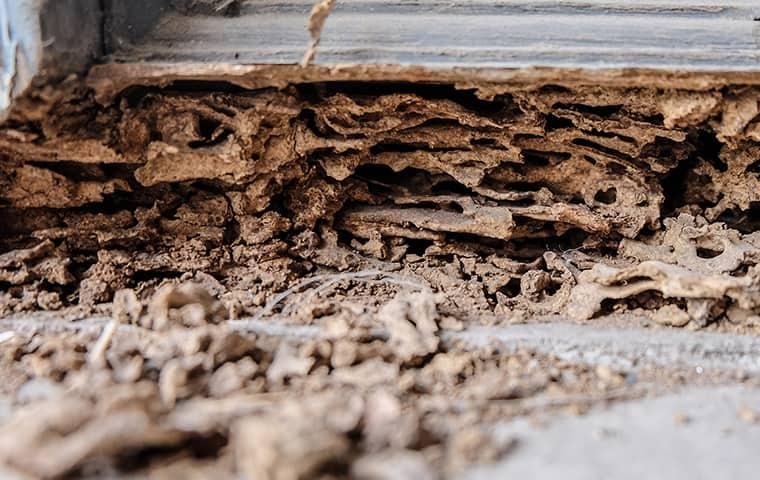Termite Damage Vs Wood Rot All you need to know

Termite damage and wood rot can both cause significant structural harm to a home. While they may seem similar, the two types of damage are actually quite different.
Wood rot is caused by fungi that feed on and break down decaying or damp wood. Common signs of wood rot include discolored and sagging drywall, crumbling or soft spots in baseboards and trim, mold on wooden surfaces, musty odors, and/or weakened floors or ceilings.
In instances where large amounts of moisture are present, such as a leaking roof or plumbing issue, more serious forms of decay like white rot can occur. To repair wood rot damage typically requires removal of the affected area(s) followed by replacement with new materials.
Termite damage, on the other hand, is caused by tiny insects that feed on wood. Tell-tale signs of termite infestation include piles of sawdust near wooden structures, mud tubes running along walls or foundation beams, wings and/or swarmer termites in the house (which are typically present in springtime), and hollowed out or weakened wooden structures.
Termite damage can be repaired depending on the severity; however it is important to remove any active infestations before attempting repairs as termites will continue to consume wood until eliminated.
If there is extensive damage throughout a structure due to years of unchecked activity, it may require complete replacement for a permanent solution.
It is always best to take preventative measures and make routine inspections to catch any potential problems early.
What Is Termite Damage And what is Wood Rot?
Termite damage and wood rot can cause significant problems in your home if not identified and addressed quickly.
Termite damage is caused by wood-eating insects, most commonly subterranean termites that burrow into the wood to feed on it for nutrients.
This type of insect infestation can weaken the structural integrity of wooden supports, walls and furniture.
Wood rot is a fungal decay that affects wood due to moisture buildup from leaks or flooding as well as condensation.
It looks like dark patches or streaks in the wood and causes it to become soft and spongy over time.
Both termite damage and wood rot can be prevented with regular inspections and proper maintenance of your home’s exterior surfaces such as decks, patios, siding, and roofs.
Repairs should be performed promptly to avoid further damage and potential costly repairs.
Additionally, using pest control methods can help keep your home safe from termites by making them undesirable places to live.
Whether treating existing wood rot or preventing future infestations, timely intervention is the best way to protect your home’s structural integrity.
Taking these preventative steps now can save you from costly repairs down the road.
The Difference Between Termite Damage And Wood Rot

If you think your home may be affected by termites or wood rot, one of the best ways to identify which issue is present is to look for the signs and symptoms associated with each.
Termites are small winged insects that feed on cellulose material, such as wood in your home.
They typically leave behind distinct signs of damage: areas of soft, thin-layered wood, mud tubes along walls, cracked paint with sawdust trails underneath it, and discoloration of wood.
These characteristics make them easy to spot if you know what to look for.
Wood rot occurs when moisture sits in the same area for an extended period of time. Eventually this can cause fungi or bacteria to begin decaying the wood, leaving it weakened and crumbly.
The damage from wood rot appears as dry, cracked, powdery surfaces that are often discolored. There may also be a musty odor present in the area.
The best way to distinguish between the two types of damage is by looking closely at the signs and symptoms associated with each.
If you’re still unsure, consult a professional to determine which issue is present.
Once identified, you can then take steps to repair the damage and prevent future issues from occurring. Taking steps to protect your home from termites and wood rot can save you time, money, and hassle in the long run. Keep an eye out for signs of damage and take action as soon as possible. It’s better to be safe than sorry!
The Signs Of Termite Damage Or Wood Rot In Your Home Or Property
It is important to be able to recognize the signs of termite damage and wood rot in your home or property. This is because if left unchecked, the damage caused by these insects and fungi can become serious and even cause structural damage to the building.

Common signs of termite damage include:
- Cracked or bubbling paint on walls: This is one of the most common signs of termite damage, as it reveals that the wood underneath has been weakened by termites.
- Sagging floors: Termites can cause the wood in your flooring to weaken and buckle, resulting in a sagging floor.
- Hollow-sounding wood when tapped: Tapping on a piece of wood can reveal whether it has been damaged by termites. If the wood sounds hollow, this is an indication that termites have eaten away at the inside of the wood.
- Visible mazes or tunnels in wood: Termites will sometimes leave behind visible traces of their activity in the form of mazes or tunnels in the wood.
- Presence of mud tubes near foundations or other wooden structures: Termites will often build mud tubes near the foundation of your home or other wooden structures. These mud tubes are visible indicators that termites may have invaded your property.
- Piles of wings near windowsills or door frames: When termites swarm, they can leave behind piles of wings near windowsills or door frames. This is another indicator that termites may have infested your home.
- The presence of visible termites: If you see any visible termites on the affected area, this is an indication that termites are present and active. It’s important to take action as soon as possible in order to prevent further damage from occurring.
Wood rot is caused by fungi that feed on wood and can cause significant damage if left unchecked. Common signs of wood rot are:

- Discolored: Wood rot can cause wood to become discolored, ranging from yellowish-brown to almost black.
- Cracked or softening walls and floors: If the affected area is left unchecked, it can lead to cracks in the walls or floors, as well as a softening of the materials underneath.
- Dry rot which causes greyish-white spongy patches on walls: Dry rot is caused by moisture-loving fungi that feed on wood and can cause significant damage if left unchecked. It often manifests itself as greyish-white spongy patches on walls.
- Wet rot, which causes dark patches of discoloration on walls: Wet rot is caused by water-loving fungi that feed on wood and can cause severe damage if left unchecked.
What to Do If You Suspect You Have Termites Or Wood Rot In Your Home

If you believe you have a termite or wood rot infestation, it is important to take action right away.
Ignoring the problem will only make the situation worse and can lead to costly repairs or even structural damage.
The first step is to confirm if your suspicions are correct by contacting a pest control professional.
They will be able to assess the extent of the infestation and determine what type of treatment is needed.
This may involve using baiting systems, insecticides, fumigation, heat treatments or other methods depending on the severity of the issue.
If you do find that your home has been affected by termites or wood rot, it’s important to start taking preventative measures as soon as possible.
This may involve regular inspections of your property, the use of termite or wood rot resistant building materials, and sealing any cracks or crevices in your home that could provide a gateway for further infestation.
It’s essential to also address any moisture problems within your home as this can increase the risk of wood rot or termites.
Make sure you check pipes and windows for leaks, ensure good ventilation throughout your house, clean gutters regularly and ensure there is adequate drainage around the foundation of your home.
Finally, contact an experienced pest control company to help eradicate any existing pests and protect against future infestations.
They will be able to advise you on the best methods to get rid of termites and wood rot, as well as preventative treatments to keep your home safe.
It is also important to inspect and repair any damaged wood in your home that could provide a gateway for further infestation.
Don’t let termites or wood rot ruin the value of your home – take action now to protect your property and ensure peace of mind.
With the right pest control professional by your side, you can have confidence knowing that you’re doing everything you can to protect your investment from damage caused by these destructive pests.
How Can You Prevent Termite Damage And Wood Rot In Your Home Or Property?
Inspection and treatment of your home or property is the best way to prevent termite damage and wood rot.
Regular inspections, at least once a year, are necessary in order to identify any potential problems before they become serious.
Inspectors can look for signs of infestation, such as discarded wings, mud tubes and sawdust. If you hire an inspector, make sure they are certified and experienced with dealing with wood-destroying pests.
Preventative treatments are also important to help keep termites away from your home or property before they cause expensive damage.
Treatments may include sealing cracks and crevices around your foundation that can allow entry points for pests.
Additionally, you should maintain proper moisture levels in your house by repairing leaks, using dehumidifiers and reducing standing water around your home.
You can also reduce the risk of termite damage and wood rot in your yard by removing dead trees or tree stumps, regularly trimming overhanging branches and avoiding stacking firewood too close to your home.
You should also keep mulch away from the foundation of your home as it can attract pests.
If you need help managing these risks, a pest control professional can provide advice and assistance.
By taking proactive steps and being aware of potential signs of infestation, you can dramatically reduce the risk of costly termite damage or wood rot occurring in your home or property. Regular inspections, preventative treatments and proper maintenance are all important components of a comprehensive termite management plan.



